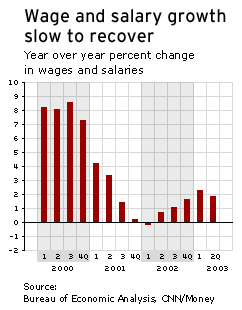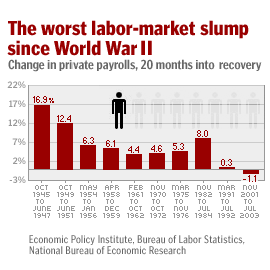NEW YORK (CNN/Money) -
Even if you've managed to keep your job during the nation's longest labor market slump since World War II, you've probably felt some of the pain in your paycheck -- and there's a good chance you'll keep feeling it, unless the labor market turns around soon.
Though the economy has grown steadily since the 2001 recession, the labor market has been a different story -- 2.7 million jobs have been slashed since March 2001, when the recession began. The unemployment rate has risen to 6.2 percent, and most economists don't expect it to fall much below 6 percent, even if economic growth picks up, as expected, next year.

With 9 million Americans unemployed and 4.6 million more part-time workers seeking a full-time job, the labor market belongs to the buyers -- the employers, that is -- and wage and salary growth has slowed.
"The increase in unemployment and the lack of job creation has dramatically altered the beneficial dynamic that prevailed in the latter half of the 1990s, when tight labor markets and faster productivity growth fueled broad-based wage gains," wrote Jared Bernstein and Lawrence Mishel, labor economists at the Economic Policy Institute, a Washington think tank, in a recent research paper.
In the late 1990s, when the unemployment rate dipped below 4 percent, wage and salary growth, as measured by the Commerce Department, rose at an average rate of 7 percent a year. Even as stocks plunged in 2000, wages and salaries grew 8 percent.
Survey says: small raise
That growth rate dropped to 2.4 percent in 2001 and a paltry 0.9 percent last year. While it bumped up to a 1.9 percent year-over-year growth rate in the second quarter, it's still far from its heyday, and recent surveys hint wage growth will stagnate well into next year.

Small businesses, some of the economy's most important employers, since they're often the first to hire in an upturn, have slowed wage increases to levels not seen since the last "jobless recovery" in the early 1990s, and they don't plan to raise wages much in the next three months, according to a recent survey by the National Federation of Independent Business.
In that survey of 1,160 small firms, only 15 percent gave raises in the past three months, the lowest rate since March 1992. Only 10 percent plan to give raises in the next three months, only one point above the record low rate of 9 percent, set in February.
"Pressure on employee compensation is winding down, but the process is slow," the federation said.
A recent survey of 110 human resource executives, by Chicago manpower firm Challenger Gray & Christmas, found that 87 percent of respondents planned to keep pay raises this year between 2 and 5 percent.
The firm's CEO, John Challenger, pointed out the bright side of the survey: that 98 percent of the firms planned to give raises, and that 72 percent planned to give bonuses.
| Related stories
|

|
|
|
|
"Even if raises and bonuses are below what they were four or five years ago...rewarding employees who have brought the company through tough times is accepted by more and more companies," Challenger said.
But Challenger also noted that employers were giving out raises and bonuses instead of hiring new workers, a situation likely to continue until at least next year.
And slow wage growth could continue through 2004, as well -- a survey of 1,700 employers by Mercer Human Resource Consulting found that planned pay raises for 2004 averaged 3.5 percent, up just a bit from the 3.3 percent average raise in 2003.
"Employers are less concerned with 'chasing the market' in terms of pay. They are more internally focused on what they can afford," Mercer spokesman Steven Gross said in a statement. "They can do this because the balance of labor supply and demand has tilted in their favor, at least temporarily."
The productivity bonus
One reason wages haven't fallen off the table in this environment is the strength of productivity, a measure of output per worker hour, which grew in 2002 at the fastest rate since 1950. Productivity cuts corporate costs and lifts profits, which makes raises and bonuses possible.
"We're seeing the productivity gains split up between wage increases and profits," said Scott Brown, chief economist at Raymond James & Associates.
Several analysts were excited when the Commerce Department reported corporate profits grew at an 11 percent rate before taxes and other items in the second quarter, calling it a hopeful sign for future hiring and wage growth.
But after taxes corporate profits actually fell 3.4 percent, and the annual rate of "undistributed profits" -- what's left for companies after taxes and dividends -- tumbled 64 percent. At the second-quarter pace, all U.S. companies will have a grand total of just $13.9 billion left over for raises, bonuses, investment and expansion.
"That's not a lot of money available to hire new workers and invest in new equipment -- if businesses wanted to do that, and that doesn't seem to be case," said Richard Yamarone, chief economist at Argus Research.

|

